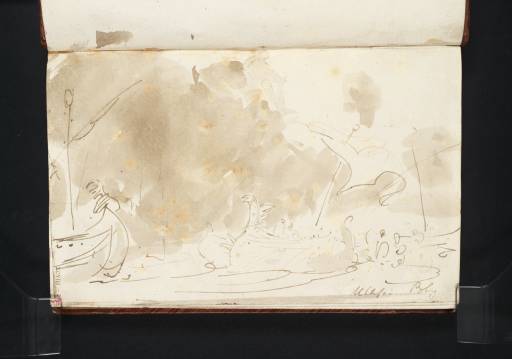Joseph Mallord William Turner Ulysses and Polyphemus 1805
Joseph Mallord William Turner,
Ulysses and Polyphemus
1805
Joseph Mallord William Turner 1775–1851
Folio 5 Recto:
Ulysses and Polyphemus 1805
D06186
Turner Bequest XCVIII 5
Turner Bequest XCVIII 5
Pen and ink and brown wash on white laid paper, 117 x 182 mm
Inscribed by Turner in ink ‘Ulysses Poly’ bottom right
Inscribed by John Ruskin in red ink ‘5’ bottom left, descending vertically
Stamped in black ‘XCVIII 5’ bottom left, descending vertically
Inscribed by Turner in ink ‘Ulysses Poly’ bottom right
Inscribed by John Ruskin in red ink ‘5’ bottom left, descending vertically
Stamped in black ‘XCVIII 5’ bottom left, descending vertically
Accepted by the nation as part of the Turner Bequest 1856
Exhibition history
References
1909
A.J. Finberg, A Complete Inventory of the Drawings of the Turner Bequest, London 1909, vol.I, p.253, XCVIII 5, as ‘Study for picture of “Ulysses & Polyphemus”’.
1974
Gerald Wilkinson, The Sketches of Turner, R.A. 1802–20: Genius of the Romantic, London 1974, p.84 reproduced in colour.
1977
Gerald Wilkinson, Turner Sketches 1789–1820, London 1977, p.121 reproduced in colour.
1984
Martin Butlin and Evelyn Joll, The Paintings of J.M.W. Turner, revised ed., New Haven and London 1984, p.184.
1990
Kathleen Nicholson, Turner’s Classical Landscapes: Myth and Meaning, Princeton 1990, pp.270 reproduced, 272–4.
1990
Andrew Wilton and Rosalind Mallord Turner, Painting and Poetry: Turner’s ‘Verse Book’ and his Work of 1804–1812, exhibition catalogue, Tate Gallery, London 1990, pp.125, 142.
1993
David Hill, Turner on the Thames: River Journeys in the Year 1805, New Haven and London 1993, pp.64 reproduced pl.77, 65, 167, as ‘Composition of “Ulysses [and] Poly[phemus]”’.
1998
Judy Egerton, National Gallery Catalogues: The British School, London 1998, pp.282, 284 reproduced fig.1, 289.
Gerald Finley, Angel in the Sun: Turner’s Vision of History, Montreal & Kingston, London and Ithaca, pp.62, 63 reproduced fig.36, 221 note 44.
2004
Kasper Monrad, David Blayney Brown, Anne Lyles and others, Turner and Romantic Nature, exhibition catalogue, Statens Museum for Kunst, Copenhagen 2004, pp.120, 124 reproduced in colour fig.12, 247 .
This is one of two complementary subjects from Homer’s Odyssey in this sketchbook, the other being Ulysses’s encounter with Nausicaa while shipwrecked on her island; see folio 3 (D06183). The two episodes reveal contrasting extremes of Ulysses’s character; humble and dependent while with Nausicaa, bold and defiant when confronting the giant Polyphemus, who reclines in his cloudy mountain cave as Ulysses’s ship sails past. Wilton suggests a further link with Turner’s ideas for a picture of Chryses, a subject from Homer’s Iliad, also set out in the sketchbook (see chiefly folios 3 verso and 4; D06184, D06185). Turner’s Ulysses Deriding Polyphemus – Homer’s Odyssey (National Gallery, London),1 exhibited in 1829, gives appropriate numinous manifestations to the elements of mountains, sea and sun while the Chryses studies make light, as a personification of the sun-god Apollo, a protagonist in the story.2
Butlin and Joll appear to discount the present drawing as a study for the 1829 picture on the grounds that there is ‘no connection in composition’.3 However, as Hill points out, it is in fact close in many respects, notably in the relative positioning of the giant (though in the picture the pose is changed to the left) and of Ulysses’s ship and the division of the composition into areas of darkness and light. It is certainly evidence of the long gestation of the picture in Turner’s mind. As Hill further observes, the paper is splashed with oil, suggesting that Turner may have had the drawing beside his easel as he worked on the picture or his oil sketch for it (Tate N02958).4
David Blayney Brown
July 2008
How to cite
David Blayney Brown, ‘Ulysses and Polyphemus 1805 by Joseph Mallord William Turner’, catalogue entry, July 2008, in David Blayney Brown (ed.), J.M.W. Turner: Sketchbooks, Drawings and Watercolours, Tate Research Publication, December 2012, https://www

